Common Bodybuilding Myths And The Real Truth By: Paul Lucas
Myth: Muscle soreness from
a workout is what makes your muscles grow.
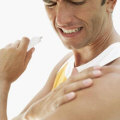 What
makes your muscles grow is HORMONES, and to get the right muscle building
hormones to come out all depends on your overall lifestyle as a bodybuilder,
this includes proper nutrition and exercise on a continuous basis. Muscle
soreness is NOT an indicator that it's growing, but it is an indicator that it
has the potential to grow and repair to adapt to the stress that was put upon
it, and once again this can only come from proper hormones, if you follow the
articles in this website you should have no problems gaining muscle or losing
fat. Muscle soreness is normal, especially if you haven't hit a specific muscle
group in a while. Also, I would not worry about the soreness, you can still get
stronger without even being sore. What
makes your muscles grow is HORMONES, and to get the right muscle building
hormones to come out all depends on your overall lifestyle as a bodybuilder,
this includes proper nutrition and exercise on a continuous basis. Muscle
soreness is NOT an indicator that it's growing, but it is an indicator that it
has the potential to grow and repair to adapt to the stress that was put upon
it, and once again this can only come from proper hormones, if you follow the
articles in this website you should have no problems gaining muscle or losing
fat. Muscle soreness is normal, especially if you haven't hit a specific muscle
group in a while. Also, I would not worry about the soreness, you can still get
stronger without even being sore.
Myth:
Calories burnt during a workout (especially cardio) is
the true fat loss benefits you get from your workouts.
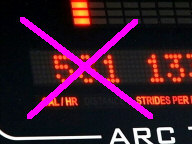 NEVER
listen to this, there's no such thing as getting results from calories burnt
during exercise. NEVER
listen to this, there's no such thing as getting results from calories burnt
during exercise.
Specifically, the prevailing focus on burning calories
is misguided, because calories burned during exercise is a relatively minor
benefit. The major benefits of a properly designed exercise routine are
metabolic and hormonal in nature.
Each time you exercise, you
temporarily alter the hormonal environment inside your body.
The more
effort you put into something (intensity) the more Growth Hormone will be
secreted, doing low intensity will release little to none at all.
Quick
sprints (interval training or wind sprints), has far greater cardiovascular
benefits than low intensity cardio, it improves your aerobic capacity (Vo2max)
two or three times greater, which will help with weight lifting better. You'll
get like 5 times greater GH release and testosterone release, which equates to
far greater fat burning than if you just did low intensity for longer durations.
You must look at exercise as a strategic way of stress that your body will adapt
to. Your body changes shape to help you perform your daily activities better,
and it does all this by hormones.
Your body will look more amazing by simply upping the
intensity of your workouts and not worrying about the
calories burnt!
Myth: To promote maximum muscle definition (especially for a
contest) you need to do only a few sets with heavy weight
and a low number of reps.
Although this statement is good for building muscle, it
actually is not the most effective way of promoting high
amounts of definition. Then what does? High reps (10+ reps)
and more sets, brings out the definition in the muscles, and
it does this by triggering a hormone that increases muscle
glycogen storage making your muscles appear to be really
"buff" or filled with tons of carbs, making your muscles
harder and appear to be bigger than they really are. Another
good thing about high reps is it improves your form, and
increases your endurance, besides all that, they are a waste
of time, as high reps is not that good of a muscle builder
than low reps are. Heavy weight (under 8 reps to failure)
triggers hormones that will increase your muscle mass growth. But
if you really want to fill up your muscles with glycogen
(simply stored carbs inside muscle), then high reps, and
more sets can do this for you.
Doing large amounts of High reps increases glocolysis, which
is the process of storing carbs into your muscles as
glycogen. Doing low reps does not trigger glocolysis as much
as high reps do. When you have more carbs stored in your
muscles, they appear to be bigger and your muscles actually
blow up kind of like a balloon, but the actual muscle is
still the same size as when you have no carbs in your
muscles. There's no theory about it. Although high reps do
jack crap for building muscle unlike high weight low reps
do.
So if you're preparing for a contest or just want to look
good for some event, or just want to look buff all the time,
then do high reps. But if you want to get stronger, and
build more actual muscle, then do lower reps.
Also,
a low body fat percent will make your muscles more visible,
instead of it being hidden by fat, so yes cardio and high
reps do bring out the definition.
here are some more tips if your concerned about more muscle
definition:
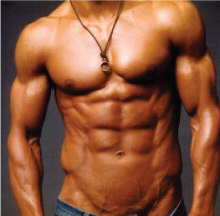
- If you have plenty of muscle mass and a low bodyfat percent,
but with hardly no definition, try the following to increase
definition:
- Eat tons of complex carbs to fill your muscles up with
glycogen, I mean tons, tons of pasta, oatmeal, potatoes
etc.. The more glycogen you have in your muscles the bigger
and harder you get.
-
Make sure your doing enough sets and reps, the more reps and
sets you do, the more your body triggers glycolysis which
pulls more carbs into your muscles. Although don't do to many
sets/reps of course.
-
Shave body hair. This helps to promote more definition.
- Lower your sodium intake, this lowers the amount of water
between your skin and muscles.
-
Increase your potassium intake.
- Ok lets say your at a low body fat percent (enough to see
your ab muscles), and this is all done mainly by diet and
intense cardio. Now since we got that out of the way,
there's
2 more things we need to bring out the definition: muscle
glycogen, and water depletion between the skin and muscles.
- To get muscle glycogen, bodybuilders entering a contest
would deplete their body's of carbs, then carb load for a
series of days. To help increase muscle glycogen they do
high reps with more sets (this really give you that
bodybuilder look).
-
Then to really get cut they do a sodium depleting/potassium
loading process , they cut their sodium intake to 400mg or
less of sodium a day, that will bring out the veins and
muscle fibers will start showing even. Also they shave their
body hair, which also helps to show more definition. Then
they are ready for a contest.
-
If you skipped the part of not doing high reps during the
carb loading process, your muscles will look more deflated
rather than "full and hard".
-
I once thought high reps was useless too, but they can be
done for strategic purposes to "pump" you up.
Myth: Doing cardio first thing in the morning is the best
way to lose fat from cardio.
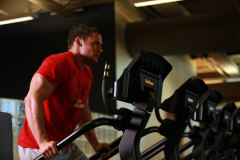 This has to be the biggest myth around! Do cardio when you
feel like you have the most intensity to do it (which for me
is in the evening). Also, keep your cardio workouts short
and intense. You don't have to do it on an empty stomach,
have a protein/fat meal before you do it, this allows more GH to be
secreted efficiently while you do it, then eat carbs after.
Remember the hormone insulin prevents GH from being
secreted, eating too many carbs (especially simple carbs)
before an intense workout is not smart. This has to be the biggest myth around! Do cardio when you
feel like you have the most intensity to do it (which for me
is in the evening). Also, keep your cardio workouts short
and intense. You don't have to do it on an empty stomach,
have a protein/fat meal before you do it, this allows more GH to be
secreted efficiently while you do it, then eat carbs after.
Remember the hormone insulin prevents GH from being
secreted, eating too many carbs (especially simple carbs)
before an intense workout is not smart.
The fat loss benefits you will get from cardio is hormonal
benefits that speed up your metabolism to burn fat
afterwards. The more intense you do your cardio the more
hormones will be secreted, specifically GH, TSH, T4, T3, and
testosterone. Try interval training or short intense runs
that are only like 10 - 20 minutes. Also do cardio only
several times a week, not every day.
Remember, burning fat during cardio is not the real fat loss
benefits you get from cardio, its all about adaptations to
your environment, and this is all done by hormones.
Myth: In order to get really big, you
have to eat a super-high-calorie diet.
 Well, that's true; you'll get really big if you eat a super
high-calorie diet, but you'll look like the Michelin Man's
fraternal twin. However, if you want to get big, lean-tissue
wise, then super-high-calorie diets are probably not for you
unless you are one of those very few people with a
metabolism so fast you can burn off these calories instead
of depositing them as fat. Unfortunately, studies show that,
in most people, about 65% of the new tissue gains brought
about by high-calorie diets consists of fat! Of the
remaining 35%, approximately 15% consists of increased
intracellular fluid volume, leaving a very modest percentage
attributable to increased lean muscle mass. Well, that's true; you'll get really big if you eat a super
high-calorie diet, but you'll look like the Michelin Man's
fraternal twin. However, if you want to get big, lean-tissue
wise, then super-high-calorie diets are probably not for you
unless you are one of those very few people with a
metabolism so fast you can burn off these calories instead
of depositing them as fat. Unfortunately, studies show that,
in most people, about 65% of the new tissue gains brought
about by high-calorie diets consists of fat! Of the
remaining 35%, approximately 15% consists of increased
intracellular fluid volume, leaving a very modest percentage
attributable to increased lean muscle mass.
You must eat to grow, not to gain extra "fat" weight.
Simply, a modest amount of calories is all you need to gain
muscle while keeping the fat in check.
Stay away from the super-high calorie diets unless you're a
genetic freak, or you're woefully lean and don't mind
putting on fat.
Myth: While trying to gain muscle mass it is wise to cut
back cardio doing low intensity with long durations to help
keep the fat off while still being able to gain muscle.
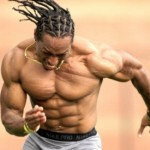 While it is true you can gain muscle faster cutting back on
the cardio, it is not true to simply lower your intensity of
the cardio workouts to help keep your fat in check as the
best way to stay lean while building muscle mass. While it is true you can gain muscle faster cutting back on
the cardio, it is not true to simply lower your intensity of
the cardio workouts to help keep your fat in check as the
best way to stay lean while building muscle mass.
If you do decide to do cardio while gaining muscle (bulking
up), then only do a few short sprints, nothing big. Don't do
low intensity longer duration crap.
Once, maybe twice a week (or like once every 5 days or so),
jog real slowly for a few minutes just to warm up, then do
like two 30 second sprints (at maximum intensity), that's
it.
The key here is to not get your workout into a heavy aerobic
condition, but rather a anaerobic condition. This allows
your hormones to keep you in anabolism for muscle tissue
while helping you stay lean. I've done this for years and it
works.
Myth: The more you work out, the
more you'll grow.
No, no no. This is one of the most damaging myths that ever
reared its ugly head. 95% of the pros will tell you that the
biggest bodybuilding mistake they ever made was to
over-train--and this happened even when they were taking
steroids. Imagine how easy it is for the natural athlete to
overtrain! When you train your muscles too often for them to
heal, the end-result is zero growth and perhaps even losses.
Working out every day, if you're truly using the proper
amount of intensity, will lead to gross overtraining. A body
part, worked properly, ie. worked to complete, total
muscular failure that recruited as many muscle fibers as
physiologically possible, can take 5-10 days to heal.
To take it a step further, even working a different body
part in the next few days might constitute overtraining. If
you truly work your quads to absolute fiber-tearing failure,
doing another power workout the next day that entails heavy
bench-presses or deadlifts is going to, in all probability,
inhibit gains. After a serious leg workout, your whole
system mobilizes to heal and recover from the blow you've
dealt it. How, then, can the body be expected to heal from
an equally brutal workout the next day? It can't, at least
not without using some drugs to help deal with the catabolic
processes going on in your body [and even then they're
usually not enough.
Learn to accept rest as a valuable part of your workout. You
should probably spend as many days out of the gym as you do
in it.
Myth: My bench press is not going up so
I'm going to have to
do chest day more often with more sets.
If your stuck,
don't blame your workout, you need to look at
other lifestyle patterns that will up your bench press. If
your doing any cardio, cut back on it or stop it altogether.
Make sure your eating enough food to keep growing, make sure
you eat at least 5 balanced meals a day. The main reason
usually comes from your daily calorie intake. By
simply increasing your daily calories a tad, you will be
surprised to see your bench press (or any lifts for the
matter) go up each week. Also, remember to drink plenty of
water, get plenty of sleep and keep your intensity up as
best as you can.
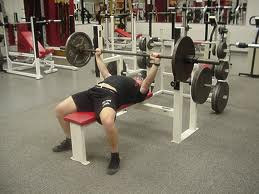
About your workout, make sure you have plenty of rest days
in-between that workout, your going to need about 5-7 days of
rest between your chest workouts. Also, don't do too many
sets, try something like this instead...
- flat bench press (3 heavy set)
- incline bench press (2 heavy sets)
- incline
dumbbell press(1 heavy sets)
- dips (2 sets add weights to your self so you do between 4-8
reps.)
Keep your reps about 4-8.
Myth: The best way
to get a six pack of abs is to do lots of crunches every
day.
There is no such thing as spot-reduction. Doing thousands
and thousands of sit-ups will give you tight abdominal
muscles, but they will do nothing to rid your midsection of
fat. Crunches will do very little in your success in
getting a 6-pack, click here to find out the
truth in how to get 6
pack abs.

General Info Articles
How to Get In Shape & Gain Weight as a Bikini Competitor
Common Bodybuilding Myths
Motivational tips
How to get 6 Pack Abs
Beginner Body building Guide
How to do Natural Cutting and Bulking Phases
Common Misconceptions In Bodybuilding
Diet Advice
General Bodybuilding Diet Info
Zig-Zag Calorie Diet
Ketogenic Diet for Rapid Fat Loss
Great Tasting Bodybuilding Recipes
Workout Info and Routines
Weight Workout Routines and Info
The Importance of Deadlifts
Dumbbells vs. Barbells - Which is Better?
How to Increase Your Bench Press
Is a Military Press the same as a "behind the neck shoulder press"?
How to Build Lower Abs
Keys to Lower Abdominal Definition
Cardiovascular Info
Understanding What Cardio Does for Bodybuilders
Track workouts
Phases of Sprinting
Track Competition Race Preparation
Supplements
What Supplements are Important for Bodybuilders
Improve Bodybuilding With Health And Lifestyle
Is this site for Women?
Hormones And Bodybuilding
The Importance of Growth Hormone
Lifestyle Factors that Effect Bodybuilding
|
